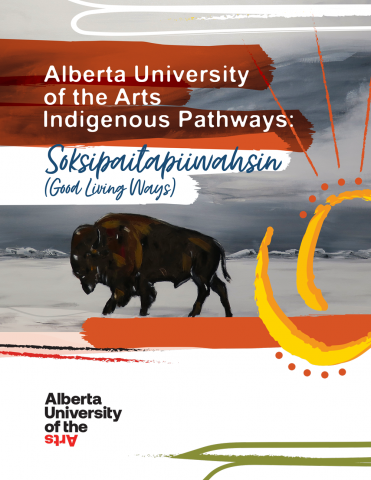Alberta University of the Arts (AUArts) now has a guiding vision for the University's response to the Truth and Reconciliation Commission’s 94 Calls to Action. The AUArts Indigenous Pathways Soksipaitapiiwahsin (Good Living Ways) was created through a consultative process led by the Elder Council and is now formally endorsed by the Board of Governors.
It results from collective efforts involving Indigenous and non-Indigenous AUArts community members over three years. AUArts Indigenous Pathways is a five-year plan – designed in parallel with our work underway on Equity, Diversity, Inclusion and Accessibility (EDIA), with themes that emerged through dialogue and consultation and articulates strategies and timelines for 10 essential goals for Reconcili-Actions that will guide the University:
- Keep enhancing the role of the Elder Council
- Establish spaces for Indigenous cultures and community within AUArts while the Lodgepole Center stands as the primary and autonomous space for Indigenous cultures and community to gather, seek knowledge, guidance and supports
- Enhance recruitment and academic success of Indigenous students
- Increase the number of Indigenous faculty and staff
- Expand Indigenous programming and curricular offerings which explore Indigenous art, life, cultures and traditions
- Facilitate research that is relevant to Indigenous life, and respects Indigenous approaches to knowledge and learning
- Engage with Indigenous communities to enrich the learning process
- Ensure that the perceptions and experiences of Indigenous community members are reflected in the classroom, on campus and in University life
- Develop and expand educational opportunities for Indigenous communities
- Ensure the process for implementing, evaluating, and redeveloping these Pathways involves Indigenous community members both within and outside the University
AUArts’ first major step towards Reconciliation was the creation of the Lodgepole Center in 2016 and its programs and supports. With the AUArts Indigenous Pathways, we now have a more ambitious vision to realize through collaboration with Indigenous Elders, Knowledge Keepers, and creatives, recognizing Treaty 7 knowledge and practices that enhance the lived experiences of Indigenous faculty, students and staff. We envision an unbiased and resilient community where both Indigenous and non-Indigenous artists, craftspersons, designers and creative thinkers who work and study here succeed.
This meaningful transformation at AUArts will take time. It may require a shift in values, attitudes, belief systems, behaviours, ongoing commitment and intention – but it is a most worthwhile and essen
There will be a celebration of this important achievement in the coming months. In the meantime, we encourage all of you to read the AUArts Indigenous Pathways Soksipaitapiiwahsin (Good Living Ways).
Many have been involved and worked hard in its creation. In particular, we acknowledge the contributions of: Darryl “Mistatay” Brass Sr., Peepeekisis Cree Nation; Darryl Brass Jr., Anishnaabek; Linda Brass, Anishnaabek; Edmee Comstock, Métis Nation; Paul Daniels, Stoney Nakoda Nation; Casey Eagle Speaker, Kainai Nation; Ruth Scalplock (Awo Taanaakii), Siksika Nation; Mary Ann Forbes, former Student Coordinator, Inuk, Nunavummiuq; Brendan Hamilton, Student, Métis Nation; Francis Melting Tallow (Mikotsi’stamik), Siksika Nation; Stephanie One Spot, Student, Tsuut’ina Nation; Troy Patenaude, Indigenous Sessional Instructor, Métis Nation; Susan Solway (Natoowok’kyiyo), former Student Coordinator, Siksika Nation.
